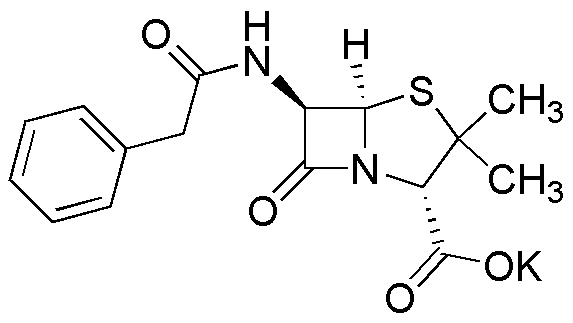Penicillin G potassium salt is widely utilized in research focused on:
- Antibiotic Therapy: It is primarily used in the treatment of bacterial infections, particularly those caused by Gram-positive organisms. This makes it essential in hospitals and clinics for managing infections effectively.
- Pharmaceutical Development: Researchers use it as a standard in the development of new antibiotics and in studies related to antibiotic resistance, helping to ensure the efficacy of new treatments.
- Veterinary Medicine: This compound is also employed in veterinary practices to treat infections in animals, ensuring their health and well-being, which is crucial for livestock and pets alike.
- Laboratory Research: It serves as a critical reagent in microbiological studies, allowing scientists to investigate bacterial growth and resistance patterns, thus contributing to advancements in microbiology.
- Quality Control: In pharmaceutical manufacturing, it is used as a reference standard to ensure the quality and potency of antibiotic products, thus maintaining safety for consumers.
Informations générales
Propriétés
Sécurité et réglementation
Applications
Penicillin G potassium salt is widely utilized in research focused on:
- Antibiotic Therapy: It is primarily used in the treatment of bacterial infections, particularly those caused by Gram-positive organisms. This makes it essential in hospitals and clinics for managing infections effectively.
- Pharmaceutical Development: Researchers use it as a standard in the development of new antibiotics and in studies related to antibiotic resistance, helping to ensure the efficacy of new treatments.
- Veterinary Medicine: This compound is also employed in veterinary practices to treat infections in animals, ensuring their health and well-being, which is crucial for livestock and pets alike.
- Laboratory Research: It serves as a critical reagent in microbiological studies, allowing scientists to investigate bacterial growth and resistance patterns, thus contributing to advancements in microbiology.
- Quality Control: In pharmaceutical manufacturing, it is used as a reference standard to ensure the quality and potency of antibiotic products, thus maintaining safety for consumers.
Documents
Fiches de données de sécurité (FDS)
La FDS fournit des informations de sécurité complètes sur la manipulation, le stockage et l’élimination du produit.
Spécifications du produit (PS)
Le PS fournit une description complète des propriétés du produit, notamment sa composition chimique, son état physique, sa pureté et les exigences de stockage. Il détaille également les plages de qualité acceptables et les applications prévues du produit.
Certificats d'analyse (COA)
Recherchez des certificats d'analyse (COA) en saisissant le numéro de lot du produit. Les numéros de lot et de lot se trouvent sur l'étiquette d'un produit, après les mots « Lot » ou « Lot de fabrication ».
Numéro de catalogue
Numéro de lot/série
Certificats d'origine (COO)
Ce certificat d'exploitation confirme le pays dans lequel le produit a été fabriqué, et détaille également les matériaux et composants utilisés et s'il est issu de sources naturelles, synthétiques ou autres sources spécifiques. Ce certificat peut être requis pour les douanes, le commerce et la conformité réglementaire.
Numéro de catalogue
Numéro de lot/série
Fiches de données de sécurité (FDS)
La FDS fournit des informations de sécurité complètes sur la manipulation, le stockage et l’élimination du produit.
DownloadSpécifications du produit (PS)
Le PS fournit une description complète des propriétés du produit, notamment sa composition chimique, son état physique, sa pureté et les exigences de stockage. Il détaille également les plages de qualité acceptables et les applications prévues du produit.
DownloadCertificats d'analyse (COA)
Recherchez des certificats d'analyse (COA) en saisissant le numéro de lot du produit. Les numéros de lot et de lot se trouvent sur l'étiquette d'un produit, après les mots « Lot » ou « Lot de fabrication ».
Numéro de catalogue
Numéro de lot/série
Certificats d'origine (COO)
Ce certificat d'exploitation confirme le pays dans lequel le produit a été fabriqué, et détaille également les matériaux et composants utilisés et s'il est issu de sources naturelles, synthétiques ou autres sources spécifiques. Ce certificat peut être requis pour les douanes, le commerce et la conformité réglementaire.


